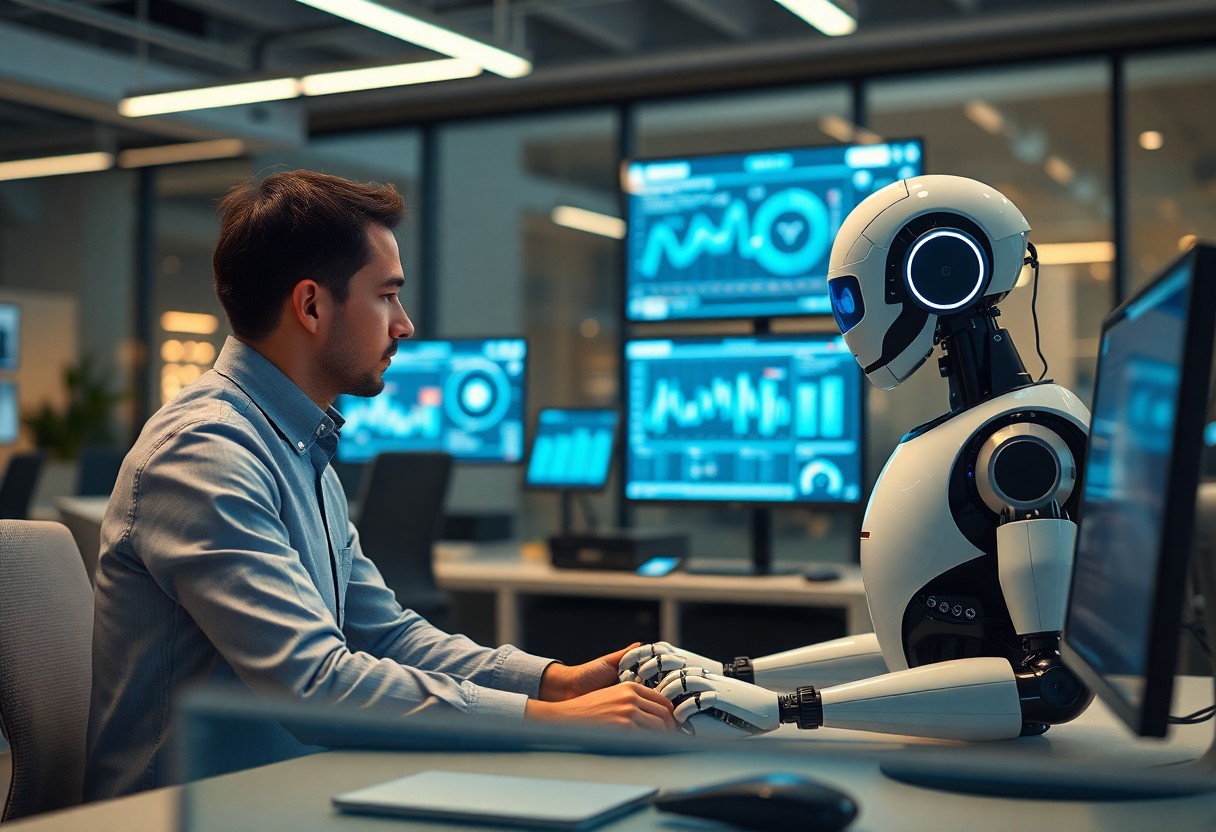Enhancing Workflows – The Future Of Human-Robot Collaboration
Top Strategies For Successful Human-Robot Teamwork
March 27, 2025Seasonal Low-Calorie Recipes – Eating Healthy Year-Round
March 28, 2025With the rapid advancement of technology, human-robot collaboration is set to redefine your workplace workflows. As robots become more capable of performing complex tasks, they can significantly enhance efficiency and productivity. This collaboration not only reduces the burden on you and your team but also aims to improve safety by taking on high-risk tasks. As you explore these innovations, understanding how to integrate robots into your work environment will be key to maximizing operational benefits while minimizing the challenges that come with this transformation.
The Evolution of Human-Robot Collaboration
While the relationship between humans and robots has progressed significantly, the integration of robotics into daily tasks is becoming increasingly sophisticated. As these machines evolve, you will notice a shift towards a more seamless interaction, emphasizing teamwork rather than competition. This collaboration aims to enhance workplace efficiency and foster innovation, paving the way for groundbreaking advancements in various industries.
Historical Perspectives
Against the backdrop of early automation, robots were primarily seen as tools to perform repetitive tasks, often devoid of any collaborative potential. Over decades, this perception shifted as human-robot interaction began to incorporate more complex systems, encouraging you to rethink how machines could support human creativity and decision-making.
Technological Advancements in Robotics
Between the early developments of robots and today’s innovations, you have witnessed significant leaps in technology that enhance human-robot collaboration. These advancements not only improve the efficiency of tasks but also expand the capabilities of robots, making them more intuitive and responsive to your needs.
But the real transformation lies in the integration of artificial intelligence and machine learning, enabling robots to adapt and learn from your actions. As a result, these machines can now perform complex tasks alongside you, enhancing productivity and safety in the workplace. With improved sensors and communication systems, robots can better interpret your actions and intentions, ensuring a more harmonious collaboration and reducing the risks associated with misunderstandings or miscommunications. This evolution not only promises greater efficiency but also fosters a sense of camaraderie between you and your robotic counterparts.
Benefits of Enhanced Workflows
It is clear that enhanced workflows through human-robot collaboration can significantly transform your workplace dynamics. By integrating robotics into your daily operations, you can unlock a wealth of benefits, from increasing productivity and efficiency to fostering a safer work environment. These improvements not only streamline processes but also provide you and your team with more time to focus on value-added tasks.
Increased Efficiency
Above all, implementing robotic systems alongside your workforce will lead to a remarkable boost in operational efficiency. Robots excel in performing repetitive and time-consuming tasks, allowing you to allocate your human resources more effectively. Consequently, your team can concentrate on strategic projects, enhancing overall output within your organization.
Improved Safety and Ergonomics
Around the workplace, safety concerns are a primary consideration for many businesses. By integrating robots into your workflows, you can significantly enhance workplace safety and ergonomics. This technology allows robots to handle physically demanding tasks or hazardous materials, reducing the risk of injury for you and your colleagues.
Indeed, the benefits of improved safety and ergonomics cannot be overstated. Athletic tasks previously performed by you can now be managed by robots, greatly diminishing the likelihood of repetitive strain injuries and allowing for a more comfortable work environment. With robotic assistance, you can mitigate exposure to dangerous chemicals and other hazards, ensuring a substantial decrease in workplace accidents. By prioritizing your health and safety, enhanced workflows help to foster a positive atmosphere while simultaneously improving your productivity.
Key Technologies Driving Collaboration
Some of the key technologies driving human-robot collaboration include artificial intelligence, machine learning, and the Internet of Things (IoT). These advancements enable more seamless interactions between humans and robots, improving efficiency and productivity in various workflows. By understanding these technologies, you can better prepare for a collaborative future in the workplace.
Artificial Intelligence and Machine Learning
Artificial intelligence and machine learning are revolutionizing how robots interact with humans. By processing vast amounts of data, AI enables robots to learn from their experiences, adapt to your needs, and anticipate your actions. This capability not only streamlines tasks but also fosters a more intuitive working relationship between you and the robot.
Internet of Things (IoT) Integration
At the core of modern human-robot collaboration is the integration of the Internet of Things (IoT). This connectivity allows devices to share data and communicate in real-time, enhancing the decision-making process and improving overall efficiency. IoT-enabled robots can respond quickly to changes in your environment, ensuring that they work cohesively alongside you.
Further, IoT integration fosters a connected ecosystem where devices can monitor and report on their status, enabling predictive maintenance and reducing downtime. By utilizing sensor data, these systems can optimize workflows and provide insights into operational efficiencies, ultimately leading to a more productive and agile workspace. As a result, you will be equipped to tackle challenges more effectively, paving the way for smoother human-robot collaborations.
Case Studies in Human-Robot Collaboration
Now, let’s explore some compelling case studies highlighting the impact of human-robot collaboration across various sectors:
- 1. *Automotive Manufacturing*: Robots increased production efficiency by 30% while decreasing workplace injuries by 15%.
- 2. *Logistics*: Implementing collaborative robots in warehouses resulted in a 25% faster order fulfillment rate.
- 3. *Healthcare*: Surgical robots improved patient recovery times by 20%, showcasing greater precision.
- 4. *Agriculture*: Robotic systems enhance crop yields by 40% and reduce labor costs by 30%.
Manufacturing Sector
Case studies in the manufacturing sector demonstrate how collaborative robots enhance productivity and safety. Facilities integrating robots with human workers typically observe a 20-30% increase in throughput and a 50% reduction in repetitive strain injuries, allowing workers to focus on more complex tasks.
Healthcare Applications
Any new adoption of robots in healthcare settings enhances operational efficiency and patient care significantly. Surgical assistance robots provide precision, reducing recovery times and allowing procedures to be conducted with higher accuracy.
Further advancements in healthcare applications illustrate how robots support healthcare professionals by automating routine tasks, thus freeing up your time for patient interaction. Data indicates that hospitals utilizing robotic systems achieve a 15-20% decrease in surgery times, while also experiencing up to 40% fewer complications. Implementing robots not only enhances the accuracy of surgical procedures, but also elevates the overall patient experience, minimizing stress and improving outcomes.
Challenges and Considerations
For those navigating human-robot collaboration, it’s necessary to recognize the various challenges and considerations that arise. Factors such as cost, integration complexity, and potential disruptions to existing workflows can hinder progress. Furthermore, understanding The Future of Collaborative Robots will help you prepare for the landscape ahead and adapt your strategies accordingly.
Social Acceptance and Workforce Impact
At the heart of collaborative robotics lies the need for social acceptance. As robots increasingly assist in workplaces, it’s vital to consider how your workforce perceives and adapts to this change. Fostering a culture of inclusivity and understanding will help alleviate fears related to job displacement and encourage employees to embrace these new technologies.
Ethical and Regulatory Concerns
Ethical questions and regulatory concerns are paramount when implementing human-robot collaborations. You must consider the potential implications on privacy, security, and worker safety.
Consequently, understanding the ethical implications of collaborative robots is necessary for creating a safe environment. You should address issues like worker privacy and the potential for misuse of data generated by robot interactions. Additionally, adherence to local and global regulations is crucial to ensure compliance and minimize legal risks. Engaging with stakeholders—including your workforce, industry experts, and regulatory bodies—will facilitate transparent discussions, ultimately paving the way for a harmonious coexistence between humans and robots in the workplace.

The Future Outlook
To fully embrace the potential of human-robot collaboration, you can expect a significant integration of advanced robotics and AI technologies into numerous industries. As these tools evolve, they will enhance productivity and efficiency, leading to greater innovation in your workplace. In this rapidly changing landscape, it’s vital that you stay adaptable and open to new collaboration strategies that include robotic partners as integral team members.
Predictions for Collaborative Work Environments
Below are a few predictions for collaborative work environments: As robots become increasingly capable, you can anticipate them taking on more complex tasks, allowing you to focus on higher-level problem solving. The incorporation of AI will drive smarter decision-making in real-time, further streamlining operations. You will also see a rise in hybrid teams, where humans and robots work together seamlessly, leading to enhanced productivity and creativity.
Role of Education and Training
Outlook emphasizes that as you navigate the evolving landscape of human-robot collaboration, the role of education and training becomes fundamentally important. You will need to acquire new skills to effectively communicate and collaborate with robotic systems, ensuring a harmonious integration into your workflow.
But, the transition towards human-robot collaboration requires ongoing education and training for you and your team. Understanding the technology behind robots will ease the integration process and allow you to leverage their capabilities. Additionally, there may be challenges associated with job displacement and the adaptation of new workflows, underscoring the importance of training programs that equip you with the skills to work alongside robots. By investing in your education, you can position yourself to thrive in an increasingly automated workplace.
Summing up
Conclusively, enhancing workflows through human-robot collaboration presents an invaluable opportunity for you to streamline processes and increase productivity in your organization. By understanding how robots can complement your skills and tasks, you can create a harmonious working environment that maximizes efficiency and innovation. Embracing this future not only prepares you for advancements in technology but also ensures that you remain at the forefront of competitive advantage in your industry.
NEWSLETTER






